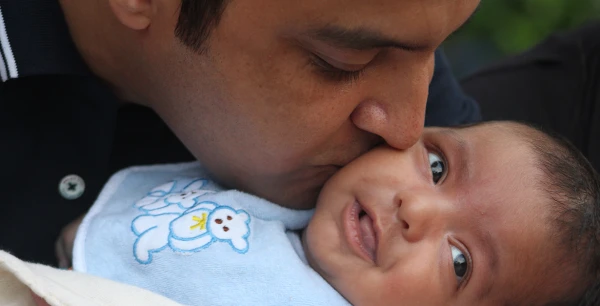Hi. I’m Kim West, The Sleep Lady. Lacey is looking for help with a “no cry it out method” to get her baby to sleep.
Here’s what she wrote:
“My daughter is 14 months old. As a baby, she had colic and silent reflux. Over the first 9 months of her life, we had to rock her to sleep to help her with the reflux during the daytime and evening naps. For her evening bedtime routine we usually have bath time, sing songs to her, put on PJs, and then I nurse or rock her to sleep.
She’s a happy baby and she’s right on track for development. But I’m concerned that I’m failing as a parent when it comes to her sleep. At 14 months old she falls asleep between 9:30 and 10:00 pm at night. Is there a way to slowly push her sleep back to 7 or 8 p.m. at the latest? I’m a full-time working mom and my husband and I both truly enjoy the time from 5 to 9 p.m. with her.”
Then, Lacey describes a lot of details about her napping. She was napping a short amount of time at 10:30 in the morning and then at 1:30 p.m. for a total of 2 to 3 hours. But now she’s pushing her nap later and later, starting anywhere from 2 to 4 p.m. and then sleeping for 2 hours. She asks what to do about the nap schedule and continues on:
“I’m a mom who doesn’t believe in the cry-it-out method. I’ve instilled an amazing trust and security bond in my daughter. I just believe in my heart that letting her cry [using the cry-it-out method] will break that bond and will cause problems down the road. Any suggestions, insights or comments that you may have to calm my worries about my baby’s sleeping pattern would be greatly appreciated. Thank you for your time.”
You Are Not Alone
Lacey, I first want you to know that you’re not alone. So many parents call and write me to say, “I feel like I’m failing. Why is this so hard? Why does sleep not come naturally?”
No Guilt
I think that in your case you did what you needed to do, particularly when she had colic and reflux. You needed to hold her, soothe her, and do whatever it took to survive until she felt better. I don’t think you should ever feel guilty about that. You’re right — it sounds like you do have a wonderful, trusting, and secure relationship with her.
A “No Cry It Out Method” Builds Attachment When Done Properly
It is possible to improve sleep for the entire family and still keep that secure bond with your daughter. One of the ways to do that is to use another sleep training method, a “no cry it out method” or gradual, gentle sleep coaching method. In these methods you do respond to her cries. You’re not leaving her alone to figure it out. You’ll be taking the kind of gentle approach that will maintain a close bond.
Adjust Her Wake Up Time
The first thing that we need to do is work on putting her down to sleep awake. You say that both dad and a grandparent are taking care of her during the day, so they may need to be involved in this.
Start by regulating her wake up time. You don’t say what her wake up time is, but I assume it’s probably later since she’s going to bed later. You might want to start by waking her about 8 a.m. or possibly 7 to 7:30 a.m. This will shift her circadian rhythm so that it will be more in line with yours and your husband’s.
Adjust Her Naptime
If she wakes up at 8 a.m., her first nap is going to be at 10 a.m. Or if she wakes up at 7 or 7:30 a.m., have her go down for a nap 2 hours after her wake up time. You might need to keep that nap short in the morning since she is 14 months old and may soon be ready to transition to one nap. She’s probably not ready for that change quite yet. Keep that nap short so that she has enough sleep pressure to go to sleep earlier in the afternoon.
If you notice that even a 45-minute morning nap pushes the afternoon nap really late, you might have to transition her to one nap. I would recommend you address her nighttime sleep issues before transitioning her to one afternoon nap.
Again, only allow a 45-minute morning nap so that the afternoon nap can start sooner. Make sure you don’t miss that afternoon nap window. If you do she may become overtired and not go to sleep until 4 p.m. Once you move her morning wake up time and nap earlier it will often automatically move the bedtime earlier. Just be sure to watch those windows.
Getting Her the Sleep She Needs
You probably really enjoy that time from 5 to 9 p.m. with your daughter. I understand that as a mom myself. Think about getting her the sleep she needs while looking for quality time in other places. If she’s feeling overtired at or 9 or 10 pm, that’s really not the quality time you hope to have with her. Figure out her appropriate bedtime and work toward putting her down then. There are actually many benefits to an earlier bedtime! Then carve out some time in the morning when she’s well-rested.
RELATED: 10 Benefits of an Early Bedtime for Your Child
Quality Time Is Not Sacrificed
I have really wonderful memories of bedtime with my children. So do my kids, who are all grown up! We remember fondly all the great stories, the bath playing, the picture books we would read together, and the things that we would talk about. It is genuine, quality time that you can still have with your daughter during the bedtime routine. Just push bedtime a little bit earlier so she’s going to bed closer to 8 p.m. As you wake her earlier in the morning and have her nap earlier you will start to see that she is ready for bedtime earlier too. Look for her sleepy cues.
Don’t Miss Her Window
If you are completely convinced that even when she naps from 1 to 3 p.m. she still doesn’t need to go to bed until much later, you could start pushing her nap back earlier to let’s say 12:30 pm. But, again, don’t miss her bedtime window. That’s the natural time to go to sleep, when our bodies secrete melatonin (sleep hormones) in a dark and calm environment. If you miss that window, she’ll get a second wind, which is probably how she’s able to make it until 10 o’clock.
Pushing bedtime back earlier in small increments at this age doesn’t work as well as it does when they are older. Instead, I want you to watch how she acts at after 7 pm, particularly when you adjust the naps and move the afternoon nap earlier.
Put Her In Bed Awake
Finally, at bedtime, you’re going to focus on putting her in her crib awake. You said you usually nurse and rock her to sleep. Now you will have your soothing bedtime routine with her room light on. I would nurse her with her light on, talk with her and if you see her starting to fall asleep I would unlatch her so she does not fall asleep while nursing. If she indicates she still wants some more milk, then you can put her back on. However, if she starts to fall back to sleep again, I think she’s just trying to nurse to sleep. I would unlatch her again. You might want to read a little book, or if she seems really tired you can put her straight in the crib.
Sometimes, when parents stop allowing a toddler to nurse to sleep, they become really stressed and say, “Oh my gosh, she’s so awake. She’s never gone into her crib that awake. I’m really worried.” Consider reading a short story to ease the transition. Again, the goal shouldn’t be to read a story until the baby is overly drowsy. That’s what we want to try to avoid.
RELATED: Drowsy But Awake — The Cornerstone of Successful Sleep Training
The Shuffle Supports A Secure Bond
After your comforting bedtime routine put her into her crib, give kisses and say “I love you sweetie pie.”Turn the lights off and the night light on, and sit next to her crib. You offer physical and verbal reassurance until she’s asleep. You can also pick her up to calm her as needed. I go over all of the rules in my book, Good Night, Sleep Tight, about The Shuffle and sitting next to her.
When you do The Shuffle you’re going to stay with her until she’s asleep. You’re going to do that each time she wakes up during the night. Then you’re going to move your chair a little farther away every 3 nights. Again, all of the details are outlined in my book. When you follow my gradual, gentle method you are responding to her, you are there for her and you are helping coach her as she learns a new skill. Doing so supports a secure bond.
There is really no such thing as a “no cry it out method” with zero tears at all. But if you follow The Shuffle, you will never leave your baby alone in a room to cry it out. You will be there to support her while she learns the skill of putting herself to sleep on her own.



